![]()
![]()
![]()
Use LEFT and RIGHT arrow keys to navigate between flashcards;
Use UP and DOWN arrow keys to flip the card;
H to show hint;
A reads text to speech;
29 Cards in this Set
- Front
- Back
- 3rd side (hint)
|
What temperature do healthy sperm develop at? What does this mean for anatomy? What muscle regulates this? |
1.1 degrees lower than the body. Testes are held outside the body Cremaster muscle |
|
|
|
Where are sperm manufactured? |
In the testes, in the seminiferous tubules. |
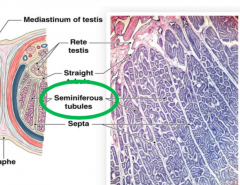
|
|
|
Within the seminiferous tubules & just outside, what cells exist and what are their role? |
1. Nurse cells: support developing sperm. 2. Interstitial cells just outside the tubule: produce testosterone. |
|
|
|
Where, when it is ready, is sperm released into after the seminiferous tubules? As they move through, what happens? (2) |
The epididymis. Maybe recycling of dead sperm, but also maturation & fluid adjustment. |
|
|
|
1. After the epididymis, where does sperm travel? 2. How does sperm travel? 3. What does it join with, and empty into? |
1. To the ductus deferens. 2. Via peristalsis. 3. Joins with a short ejaculatory duct, and empties into the urethra |
|
|
|
What is semen composed of? (3) |
1. Millions of spermatozoa 2. seminal fluid 3. enzymes e.g protease: helps dissolve mucous in vagina & bacterai killing enzymes |
|
|
|
What are the 3 accessory glands in the male reproductive system? |
1. Prostate gland 2. seminal gland 3. bulbourethral gland |
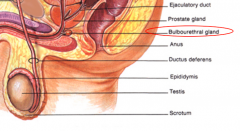
|
|
|
What does the bulbourethral gland do? (2) |
1. Secretes an alkaline fluid which neutralises urine acids 2. Produce fluids that lubricates glands of penis, which can help in intercourse |
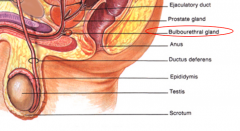
|
|
|
What does the prostate encircle? What does it do? |
The urethra Produces an antibiotic fluid that can destroy bacteria - helps maximises chances of sperm surviving vaginal flora that may be there |
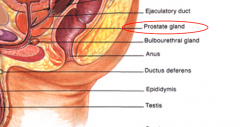
|
|
|
What does the seminal gland (vesicle) do? (3) |
1. Producing alkaline fluid to balance PH 2. Producing fructose for energy for sperm 3. needed for capacitation (activation) of sperm |
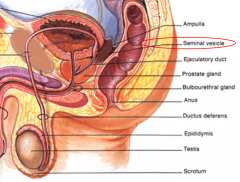
|
|
|
What are the 3 elements of the penis? |
Body, glans, erectile tissue (corpus cavernosa, corpus songiosum) |

|
|
|
What is the name of gamete production in males? When does it begin and end? What process is this? How many daughter cells from one germ cell? |
Spermatogenesis Puberty. Carries through whole life. Meiosis. 4. 4 sperm per germ. |
"4 sperm per germ" |
|
|
What are the three parts of the sperm? |
- acrosome - mitochondrial spiral (colar) - tail |
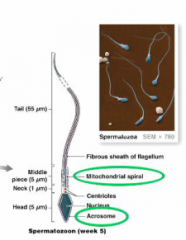
|
|
|
What is the uterine tube? How does movement occur within? What is it the site of? |
A narrow tube that carries the egg from the ovum to the uterus. Peristalsis + cillia. Fertilisation. |
|
|
|
What are the 3 layers of the uterus? From inner to outer. |
Endometrium (insider) Myometrium (muscle) Perimetrium (outer) |
|
|
|
1. What are the characteristics of the endometrium? (4) 2. What are the two "zones" of the endometrium, and what do they do? |
1. Thin. Highly vascular. Highly glandular. Shed during the menstrual cycle. 2. Functional zone: regularly grows + sheds. Basilar zone: permanent. Attaches endo to myo. |
|
|
|
1. What layer is the myometrium? 2. What type of muscle is it? 3. What role does it perform? |
1. Middle layer. Muscular, thick. 2. Smooth. 3. Contractions in labour & PMS. |
|
|
|
1. What type of tissue is the perimetrium? |
1. Serous membrane. |
|
|
|
What does the cervix produce? What is its role? |
A mucous plug. To keep the uterus sterile from the continuous vagina |
|
|
|
What is the epithelium in the vagina? What is the pH? What is interesting about the vaginal wall? |
Stratified squamous epithelium. Low (to restrict pathogen growth) Folded to allow stretch for intercourse + baby. |
|
|
|
What are the external genitalia features? (4) What do the glands do? |
Glands - produce lubrication for intercourse Clitoris Labia Majora Labia Minora |
|
|
|
What is the majority of bulk in mammary glands? |
Fat. |
|
|
|
How does gamete production decline in females? |
- born with 2million primordial follicles. Can't form more. - by puberty: 400k - only 400 will ever mature |
|
|
|
What produces hormones that maintain the lining of the uterus? |
Corpus leuteum w/in the ovary |
|
|
|
What is testosterone's primary function? What is oestrogen's primary function? |
Sperm production Help prepare lining of uterus |
|
|
|
What are the 2 roles of progesterone? |
1. Stimulates & sustains endometrial lining 2. Suppresses premature contractions ^ minimises risk of miscarriage! |
|
|
|
What leads to the production of FSH & LH? |
GNRH released from the hypothalamus stimulating the anterior pituitary |
|
|
|
What does FSH do in females? What does LH do in females? |
stimulates follicles LH: triggers ovulation |
|
|
|
What does FSH do in males? What does LH do in males? |
FSH: stimulates nurse cells & stimulates inhibin LH: stimulates interstitial cells in males // to produce testosterone |
|

